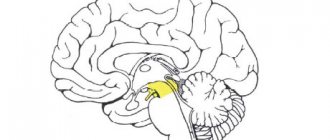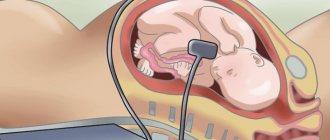A midlife crisis in women is a condition that absolutely all representatives of the fair sex will have to face. He is characterized by apathy, bad mood, and a pessimistic view of the future. And these are not all unpleasant symptoms. They have a bad effect not only on the emotional state. Often a woman’s relationships with others deteriorate. As a result, she closes herself off and is left alone with her problems. What to do in this case? How to survive the age crisis?
Midlife crisis - what is it?
A midlife crisis is a condition characterized by loss of meaning in life, apathy, and depression. A woman changes as a person. Her past attitudes and behavior patterns are no longer satisfying. There is a revaluation of values. This time they are revised taking into account life experience, new knowledge and, possibly, other views on the world around us.
The midlife crisis for women is very similar to what teenagers experience during the transition period.
At what age does a midlife crisis appear?
In psychology, it is believed that a midlife crisis is associated with changes in the psyche. That is why it is often associated with adolescence. But there are several such states throughout human life:
- at 3 years old, when the child understands that he is a person;
- at 6-7 years old - start of schooling;
- at 14-15 years old - the moment of growing up (girls worry more).
When does a midlife crisis occur for women? It's difficult to say exactly what time. According to the World Health Organization, middle age is the period of life between 30 and 45 years. But these are conditional boundaries. It is necessary to take into account the influence of factors such as culture, social development and status.
For some, a midlife crisis begins after graduating from school and going to work. For others, after marriage and the birth of their first child. It is impossible to say exactly when it will be. Especially when you consider the fact that in some universities education ends at about 25 years of age. And the birth of children is now postponed until 30, or even later.
How long does it last
The question of how long a midlife crisis lasts is difficult to answer unambiguously. This is not an acute respiratory infection in which everything will go away in a week or two. This is a state from which you may not get out. Often, experiencing such serious experiences, a woman does not find support even in her family and friends. She withdraws into herself, and those around her condemn her, considering her simply spoiled and capricious.
During the time the crisis lasts, a woman can lose everything that is dear to her. We are talking about friends, a beloved man, etc. People may not understand that she needs help. It won't necessarily ruin the relationship. In most cases, spouses continue to live together. But they can hardly be called a real family. These are just neighbors living in the same area. Between them there is not only passion and love, but even mutual understanding.
General information
The age crisis for women, like for men, is a concept that has a social context. Its course depends on many factors. Let's figure out what a crisis looks like for women.
Description, main problems
What is this - a midlife crisis? To begin with, what age should be considered average? The World Health Organization (WHO) puts the average age of women between 30 and 45 years. However, psychology does not provide clear boundaries in answering this question. In this case, the external cultural environment, the level of development of society, and social status have a great influence.
The average age of a woman during the onset of a crisis is about 40 years. The period of crisis is a transitional stage, characterized by internal problems associated with the lack of meaning in life, rethinking one’s place in it, or summing up intermediate results. This is an extremely individual and purely subjective problem, which is based on important issues and dissatisfaction in the family or professional sphere of life interests.
The main problems of this period are the following:
- Changes in appearance, which begins to show signs of fading;
- Loss of strength, physical problems. The body is no longer able to cope with diseases the way it did in youth. This leads to the formation of chronic diseases;
- Problems associated with hormonal changes and changes in the body that accompany the onset of menopause;
- A woman’s feelings associated with insufficient fulfillment in one of two areas: motherhood, or, conversely, the professional sphere;
- Full life realization. A person begins to feel that there are no goals left to move towards. Life then loses its meaning.
How the crisis begins
This largely depends on the woman’s character and temperament . Those prone to hypochondria will look for signs of crisis in themselves long before they begin to appear. A middle-aged woman who is optimistic or does not have extra time for introspection will quite possibly not notice its onset at all, or will not identify the symptoms with this condition.
In addition, research suggests that, as a percentage, only 10 to 25% of people aged forty experience a crisis condition as a diagnosis . For the rest, this stage can be considered a normal transitional age, which every person overcomes more than once in his life.
The onset of an age crisis in a woman is characterized by two successive stages.
- The first of them is the loss of illusions and groundless hopes. At this stage, a middle-aged woman most often comes to terms with the fact that the crazy dreams of her youth are left behind and are unlikely to become a reality. Of course, such a loss is accompanied by a decline in mood, vitality, and disappointment in oneself and others.
- The second stage of age-related identity psychology is characterized by the term “liminality.” The essence of this stage is that a woman, at the onset of a critical age, feels confusion and uncertainty, since under the influence of the changes that have begun, she has already left the old “herself”, but has not yet fully formed the new “herself.” In the process of developing a personality, middle-aged women often begin to reassess values and goals: the past seems incomprehensible, and the prospects for the future are not yet visible.
Features of midlife crisis in women
For clarity, the features and signs of a female midlife crisis can be compared with the features of the course of a male crisis, since they are fundamentally different. This is due to fundamental differences of a physiological and psychological nature.
| Comparison of male and female SWR | |
| Women | Men |
| Women are by nature more prone to introspection. When a crisis begins, this tendency can take on hypertrophied forms: a woman constantly tries to find out where she made a mistake or did something wrong, that is, she looks for the cause of the problems in herself. | The stronger sex rarely engages in introspection. Men blame anyone but themselves for the crisis, their troubles and failures (most often, their close circle of people). |
| A woman in crisis is withdrawn and unsure of her abilities. She also questions her attractiveness, since her youth is left behind, and public opinion most often does not favor women after 40 years. | A man is often inclined to overestimate his abilities and explain failures by external factors. In addition, society does not consider men over forty unattractive. Rather, on the contrary, at this age they become the object of attention for the category of girls of twenty to thirty years old. |
| The female crisis is extremely rarely accompanied by leaving the family. But sometimes there is a possibility of finding another partner in the case of an unregistered relationship, or new love for single ladies. | Any, even the most insignificant, family conflicts for a man in crisis can serve as a reason to “slam the door.” A fairly large percentage of men during a crisis period go to their mistress or start a new family. |
| Complexes about fading beauty and an aging body prevent a woman from fully enjoying sexual relations. This is followed by a lack of enthusiasm or a complete refusal to have sex. After overcoming the crisis, interest in sexual relations is renewed. | Feeling increased energy, men often go to great lengths to satisfy their sexual appetite. But after a crisis, given that it occurs later than a woman’s, problems of a sexual nature often begin. |
| Due to the fact that women have a shorter reproductive age, the presence or absence of children can be of great importance in the process of living through a crisis. It is believed that in the latter case, women endure the crisis more difficult, since on a subconscious level they are disturbed by a feeling of emptiness and failure to fulfill their main life role. | The presence or absence of offspring rarely affects the male crisis. A man, unlike a woman, does not consider children the meaning of his life and does not worry if he does not have them. In addition, representatives of the stronger sex remain capable of conceiving for a long time, so the “biological clock of the body” does not have such an influence on them. |
In addition, there are clearly visible features of this age period, similar in both sexes:
- Fear of loneliness, old age, death;
- Regrets about irretrievably lost years;
- Search for a new meaning in life, or attempts to seriously change its course;
- Confinement to oneself and one’s condition, limiting contacts with loved ones.
Interesting fact
Girls who grew up without a father are prone to severe crisis manifestations in middle age. But girls who were adopted children are more resilient and less likely to have a hard time going through the crisis of 40 years.
Is it possible to avoid a crisis?
A woman who is able to avoid a crisis completely is rather an exception to the rule. More often it happens that a personal crisis goes unnoticed against the backdrop of some external events that completely crowd out internal experiences. The course of the crisis, its severity and the ability to avoid it depend on the type of behavior.
Psychologists distinguish four types of behavior of a mature personality:
- Spontaneous . The life of such a person is not organized; he adapts to events on the go.
- Functional. There is no plan for life; a person only from time to time undertakes its organization and chooses areas of activity.
- Contemplative. A person relies on external circumstances, realizing only momentary plans.
- Creative. An ideal (and therefore rare) behavior option. A person controls circumstances, manages them, and is able to use external events to implement his own plans.
The last type is least susceptible to crisis. The choice of behavior always remains with the person, so the opportunity to avoid an unpleasant period is in your hands.
Positive sides
Not everything in a crisis entails problems. There are also undeniable advantages:
- A crisis in older women helps them look at themselves in a new way and change their position and behavior;
- Adolescence in women, no matter what age it begins, gives a good impetus to development. Personal growth during this period is often rapid and allows a woman to get out of the crisis not just with the least losses, but with gains.
- A crisis situation gives you the opportunity to think about whether everything in your life is going as it should. Often a nervous shock allows you to look at the situation from a different angle and understand how to act in the future.
Interesting Facts
Psychological research over the years has revealed some interesting aspects of the women's crisis.
- When there are problems in the family, women endure a crisis of 40 years more severely;
- Symptoms of a female midlife crisis are more pronounced among women working in teams and less so among managers and organizers;
- The midlife crisis in women is always accompanied by dissatisfaction with their career and chosen profession;
- When experiencing a midlife crisis, both married and unmarried women have an unconditional value for family. Married women value the need for education, self-development, communication and hobbies lower, but they value material wealth higher than unmarried women;
- For divorced women in a crisis situation, their own prestige is most important.
How it begins
So, when a midlife crisis begins in women, it’s already clear. What does it look like? Depends on the woman herself. If she is melancholic by nature, she will think about him even before it starts. If she is naturally active, she may not even notice the onset of this unpleasant condition.
According to psychologists, only 10-25% of women are diagnosed with a “midlife crisis.” For others, it manifests itself as a normal transitional age, which occurs in the life of every person without exception.
A woman's midlife crisis develops in 2 stages. At the first stage, illusions and groundless hopes disappear. The woman takes for granted the fact that her youthful dreams will no longer come true. Because of this, she feels disappointed in herself. Bad mood and lack of vital energy become her constant companions.
The second stage of the midlife crisis is characterized by uncertainty and confusion. The woman is no longer the same as she was before. But she still hasn’t decided what she wants to become. During this period, a reassessment of values and goals occurs. They may seem incomprehensible and strange. But at the same time, future prospects are also not visible. They are very blurry.
The essence of the phenomenon
Revolutionary periods accompany the fair sex throughout her life.
First period
Marks a separation from parental roots, the transition to early adulthood . A girl between the ages of 16 and 22 considers herself an independent adult. She strives to prove her independence and competence to herself and the rest of the world.
During this period, the search for oneself continues and individuality is strengthened. There is a choice of a life partner, the creation of your own home. A person realizes his own inclinations, abilities, acquires professional knowledge and skills.
Parents no longer stand behind you, and a truly independent life begins. At this time, personal responsibility begins for academic results, employment, compliance with professional requirements, and financial support.
When starting a family, a young woman has responsibilities for managing the household and raising children. The girl recognizes the need to make the right decisions and competently build a life plan.
Second
It occurs during the years of maximum performance, the highest activity in the personal, professional, and social spheres.
A woman becomes concerned about the correspondence between what she wants and the existing situation.
Awareness of the inconsistency between dreams and reality requires a person to correct the plan of action, change the ways of achieving the goal, and form a rational life structure.
By the age of 30, a woman objectively evaluates her own experience, gets rid of illusions , and looks into the future more soberly. A thirty-year-old person's preferences change. He often prioritizes stability.
Some women at this age begin to rapidly pursue a career, realizing their calling. Others give up professional growth and devote more time to family members. Still others expand their social connections and range of hobbies in the hope of finding the “meaning of life” - something that would occupy the mind and satisfy the soul.
Third
Occurs due to the realization that half of life’s journey has been completed. A discord in the worldview arises - the attitude towards what previously seemed significant changes.
At this age stage, a woman acutely experiences the loss of youth . She anticipates an unattractive old age, followed by the irreparable - death. Appearance loses the freshness and attractiveness of youth. The time is coming for the first “battle” with old age.
Some ladies get into love affairs, breaking off relations with their husbands. Others immerse themselves in work without finding other sources of confirmation of their own importance. Still others take risky actions, such as taking up extreme sports.
Fourth
Associated with the cessation of active professional activity. A woman is retiring and doesn’t know what to devote her free time to. Boredom is exacerbated by the lack of need to care for children who have become independent.
Deteriorating health and lack of energy increase psychological distress . The woman understands that the century is coming to an end, and eking out a bland existence is not interesting. She feels unwanted and may become depressed.
Main features
At every age, the crisis has its own symptoms. But there are a number of common ones:
- Lack of motivation to act, boredom, apathy.
- Change of partner, inconstancy.
- The desire to quit your job and do something else.
- Frequent mood changes. Sometimes sadness and melancholy suddenly give way to groundless joy and fun.
- Persistent feeling of anxiety, prolonged depression.
- Excessive self-criticism, self-examination, humiliation of oneself as a person.
- The desire to dramatically change yourself and your life. Moreover, changes must occur in everything, from appearance to housing.
The appearance of one of the listed symptoms of a midlife crisis in women does not mean anything. Perhaps apathy is a consequence of banal fatigue. If they appear all at once, you should sound the alarm.
How does the age crisis manifest itself in women?
As mentioned above, at each stage the midlife crisis has its own manifestations. Let's take a closer look.
20-25 years
If there are no problems, then you will not be unsettled either by an unfair teacher at a university, or by a boss who, after much debate and abuse, still raises your salary or gives you a bonus. At home, nothing will irritate you either, since family is what you should rely on in life.
But even in such seemingly ideal conditions, difficulties often occur. Let's say you recently got married. What might you encounter?
- Doubts about the correct choice. Perhaps the man did not live up to your expectations.
- Quarrels with parents. Maybe your husband’s mother didn’t accept you, and your family didn’t accept him.
- You really want a child, but you can’t get pregnant.
- You become pregnant, but your man does not want children and insists on terminating the pregnancy.
- The birth was very difficult and led to depression.
These factors provoke the development of a crisis. A woman faces apathy, begins to look for the reasons for what is happening within herself, and becomes despondent.
30-35 years
After 30 years, women suffer from the fact that they were never able to realize their plans and ideas. Let's say you were absorbed in work for many years, building a career and did not have time to start a family and give birth to a child. On the one hand, it is not too late to do this. On the other hand, you will have to sacrifice your position and what you have been striving for for so long. Duality and uncertainty spoil the mood and drive you into stress.
There is another scenario for the development of events during a midlife crisis during this period. Perhaps you have created a family and given birth to children. But because of this they were unable to build a career. You don't have to worry too much about this. But those around you are still looking for an opportunity to mention this moment. This could be a work-related girlfriend or a husband who has also reached certain heights. Agree, it’s unpleasant if at some point he says that he has nothing to talk to you about.
40-45 years
The degree of manifestation of midlife crisis symptoms during this period intensifies, since after 40 years a woman’s body undergoes serious changes. To a greater extent, this concerns hormonal levels. And, as you know, it is closely related to the emotional state. Plus, many women are faced with excess weight, gray hair, and wrinkles, which cannot but upset them. Some find it possible to turn to plastic surgery. Others can't afford it.
It turns out that at 40-45 and after 45 years of age, the crisis is associated with the fear of losing youth, attractive appearance, the ability to give birth to a child and build a family.
Another factor that provokes the development of a midlife crisis is the fear of loneliness. For most women, by this time, children have already become adults and leave their father's house. A once loving and beloved man either leaves the family or starts an affair on the side, perhaps with a younger competitor. There's no point in talking about work. Nowadays it is very easy to remain unemployed.
Manifestations
Critical periods make themselves felt by psycho-emotional, cognitive, and behavioral symptoms.
Leading signs:
- discomfort,
- fixation of attention on experiences,
- obsessive thoughts on a certain topic.
For example, production conflicts are constantly running through your head and do not allow you to switch to communicating with friends.
During a crisis, one of the dominant psycho-emotional phenomena comes to the fore:
- depression;
- destructive experiences;
- feeling of loneliness;
- maladjustment.
Depressive reaction
A woman in crisis loses interest in previously exciting activities. Her usual, routine routine begins to irritate her. She feels the need for change.
The woman is in a depressed mood . She feels blues without any real reason. Feels that there is no strength to carry out ordinary tasks.
Destructive feelings
The woman is overcome by nervousness, anger, resentment, and hatred. She demonstrates stubbornness and envy, which causes relationships with loved ones to suffer.
The woman finds fault with the words and actions of her relatives. She is irritated by things that she previously did not attach importance to. The thought appears that those around her are acting out of spite.
Loneliness
A woman feels unloved, unwanted, and perceives the world with pessimism.
The worldview changes, a gloomy color of what is happening is formed. The level of optimism is falling, leading to gloomy forecasts. A woman perceives minor difficulties as heavy blows of fate .
I am convinced that I have to deal with difficulties alone. She believes that those around her have abandoned her. Believes that it is impossible to counteract events.
Disorganization
The woman behaves rashly and inconsistently. Physical symptoms arise, for example, vegetative-vascular crises, panic reactions. Some people “fall into illness” by convincing themselves that they have a serious illness.
Mental state negatively affects physiology . Sleep disturbances occur. A woman suffers from persistent insomnia. She has dreams with a frightening plot. He feels exhausted after waking up.
During a crisis, appetite is often lost. Insufficient, unbalanced nutrition increases weakness. A typical accompanying crisis is a debilitating headache that does not allow you to fully complete tasks.
During a crisis, an analysis of past experience and the current situation is carried out. The person begins to sum up the results, evaluate the path traveled, and establish real prospects. This requires a willingness to self-criticize, clarity and clarity of judgment. In the presence of depressive accentuation of character, a negative life balance is created.
Causes of the crisis
There are many reasons why a midlife crisis occurs. It is difficult to say what exactly will trigger its development. But we can highlight a number of main ones.
Professional stagnation
If a woman does not work for a long time, for example, because of maternity leave, she loses motivation. Or maybe at some point she realizes that she chose the wrong profession. Another option is the need to constantly be present in the workplace and develop. Even a small miss can result in her simply not being able to catch up with her colleagues.
Fear of loneliness
Sometimes at the age of 35-40 a woman has no children and no family in general. She does not want to look lonely and unwanted in the eyes of others. Because of this, he builds relationships for the sake of status. And this necessarily brings with it additional worries and anxieties.
Family
There are 2 options for the development of events. The first is when a woman gets married either for the first time or for the second time. She has new obligations, everyday problems and other difficulties. She has to change her last name. All this leads to a crisis and difficulties with self-determination. The second option is having a child (it doesn’t matter whether it’s your first or not). Here a misunderstanding arises between older children and the baby or husband. Everyone wants attention, but a woman can’t break away. And this is also a problem.
Fear of death
A midlife crisis on this basis is equally common in both women and men. A person understands that he is getting older every year. Take into account the fact that he may not be happy with something in life. If this is the case, a woman can go in two ways:
- Find someone she will blame for what is happening. Often this is a husband, work or one of the relatives. She will exclude the “culprit” from her life and try to arrange it differently. But he soon realizes that there is no escape from himself. The problem will remain unresolved.
- Relationships with loved ones, including your spouse, will worsen. But the woman will continue to live with him, feeling responsible for the family and children.
The second option is most often practiced.
Hormonal disbalance
Fluctuations in hormonal levels lead to changes in physical and emotional well-being. They are difficult to deal with. A woman begins to “twist herself” and sees problems even where there are none in reality.
Changes in appearance
Almost all representatives of the fair sex react sharply to them. The difficulty is that such changes are easy to notice, but difficult to hide.
It is especially difficult for beautiful women who are accustomed to the attention of the opposite sex.
Differences from children's
Turning points in the lives of adult women have a number of differences from crises that arise in childhood. The differences are explained by the peculiarity and speed of mental processes in a mature person:
- crises in adult women occur less frequently than in childhood and adolescence;
- the moment of their development is not strictly tied to biological age;
- the onset of the “revolutionary” stage is well understood by the person, which allows him to carry out targeted work on himself.
Crises in adulthood, in contrast to childhood transitions, carry a greater risk of disruptions in mental health with subsequent deterioration in physical condition.
An illiterate way out of the situation is fraught with irreparable mistakes, for example, dismissal from a prestigious position or a break in the marriage.
Is it possible to overcome a midlife crisis without outside help?
It all depends on the properties and characteristics of each individual person. In this regard, psychologists identify 4 behavioral models:
- Spontaneous. The woman is not organized. She never plans ahead, but adjusts her life to the events happening around her.
- Functional. There is no clear plan here either. But the person is trying to do at least something, for example, choose the direction of movement.
- Contemplative. There are plans, but only momentary ones are being implemented. At the same time, the woman hopes that circumstances will develop favorably for her.
- Creative. This behavior is the least common. A woman not only makes plans and sets goals, but also brings them to life. In addition, she knows how to use circumstances to her advantage.
Women with a creative model of behavior face a midlife crisis less often than others. But remember - everything is in your hands. How you react to a situation is up to you.
Advantages
Despite the many problems that a woman’s midlife crisis brings with it, it also has positive properties:
- Helps you look at yourself from a different perspective and, if necessary, change your thinking and behavior.
- A crisis is often an impetus for further growth and development. If you treat it correctly, you can not only avoid depression, but also gain something new.
Also, a woman has the opportunity to soberly evaluate her life, to understand whether everything in it is going the way she wanted. Perhaps something needs to be changed.
Stabilization
A successful exit from a crisis involves reformatting a person’s consciousness towards an adequate real understanding of life and its limitations. Maintaining a harmonious family and relationships becomes a priority, while one's own selfishness is relegated to the background .
A woman who has emerged from a crisis with a breakthrough in personal growth realizes how important it is to enjoy what you have, without paying much attention to things that are likely to remain unattainable. Thus, there is a tendency towards satisfaction with one’s own position and place in life.
All this marks the onset of a period of stability, an age of wisdom and understanding of life priorities . For many women, the process of renewal, launched with the onset of the crisis, ultimately leads to a calm and happy life.
If you don’t want to give up and are ready to really, and not in words, fight for your full and happy life, you may be interested in this article .
Tips for overcoming a crisis
So how to survive a midlife crisis? First you need to understand its nature. This is a psychological problem like many others. And in especially serious cases, it requires the help of a specialist. But there are some steps you can take on your own.
- Don't try to run away from the crisis. Acknowledge its existence. Don't suppress your feelings and emotions, this will only make the situation worse. It’s not for nothing that they say that awareness of a problem is the first and main step towards solving it.
- Switch your attention to something new and interesting to you. Remember what you wanted to do? Maybe drawing? Or conquering mountain peaks? Why not do it right now? By the way, sometimes a hobby brings good money.
- Change your lifestyle. We are talking about changing your diet, playing sports, giving up bad habits. In just 2-3 months you will see the fruits of these actions: clear skin, improved overall well-being, good mood.
- Consider an active holiday. Don’t think that after 30, evenings need to be spent with your family reading a book or watching TV. In any case, you need new emotions and impressions. Therefore, go to exhibitions, concerts, fairs. Try to get creative.
- Let your emotions out. One of the available ways is tears. Do not accumulate resentment and irritation within yourself. This will not lead to anything good. If you want to cry, cry. This is not weakness. Another opportunity to let your emotions out is to take up martial arts.
- Change your occupation. Just don't do it spontaneously. Make sure your job is truly a source of stress. If this is the case, create a so-called “safety cushion” and quit.
- Find someone to care for. Another way to cope with a midlife crisis. Perhaps it's time to think about children. If you have children, but have already grown up and moved away in all directions, get a pet. You definitely won't be bored. Taking care of an animal will leave no time for bad thoughts. But remember about responsibility for a living being. This is not a toy.
If these tips for overcoming the age crisis did not help you, do not hesitate to contact a psychologist. He will help you identify the root of the problem and direct energy in the right direction. Also, go see an endocrinologist. Perhaps you need to correct your hormonal levels. In this case, medications will help.
Is it possible to avoid a crisis?
Do women always have a midlife crisis? All women go through it. Some people successfully overcome it. But it also happens that it lasts a long time. It all depends on how he is treated.
It is easier to survive a crisis if you follow a number of simple tips:
- Honestly analyze what happened to you in the past.
- Accept yourself for who you are. Change if necessary.
- Prepare for a crisis in advance.
- See the transition period as a new experience.
- Don't try to hold onto your youth and the past.
- Keep busy.
New acquaintances will help you survive the midlife crisis. If a woman does not have a family, it can be a romantic relationship.
Interesting Facts
Numerous studies conducted by psychologists have revealed several interesting points regarding the midlife crisis in women. Here are some of them:
- If a woman has problems in her family, it will be much more difficult for her to survive the crisis.
- Symptoms of this condition are more pronounced in those who work in large teams. It is not so noticeable among managers.
- The transition period is almost always characterized by dissatisfaction with the chosen profession.
- During a crisis, a woman realizes the value of family. But only married women think about self-development, communication, and entertainment. And unmarried people want family gatherings and comfort.
And one more fact - women in divorce during a crisis period, first of all, put their prestige, the opinions of others, and status first.










